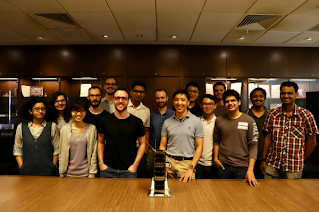Alexander Ling Group
Our group is working to bring optical quantum technology out of the lab and into the field – and even into orbit. Such field-tests of quantum mechanics pave the way for developing applications of quantum physics.
One of our team's major goals is the development of complete entangled photon experiments that are palm-sized and suitably ruggedized for use on small satellites (CubeSats or larger), and other low-resource mobile platforms. This compares to typical lab-based entanglement experiments which run in a protected environment without severe space or power constraints.
For the satellite instrument development, we tie many different branches of physics together. Our work involves a lot of system design and integration, low-power radiation-tolerant electronics and elegant opto-mechanical design. For example, proton-induced displacement damage is a major concern, and team members have been both studying radiation models in space and conducting tests on devices to understand the impact of radiation on the lifetime of our experiments.
We have also pioneered the testing of quantum systems at the edge of space using high-altitude balloons. In one recent test, instruments were carried to an altitude of 37km and successfully recovered. The test data reveal that the control systems worked flawlessly and we are looking forward to more advanced field tests.
Looking to the future, we anticipate that integrated photonics will play a large role in the miniaturisation of quantum systems. Our team also has an effort aimed at studying waveguide structures as sources of quantum entanglement, as well as studying how complete experiments may be fabricated on a single chip.
Undergraduates are encouraged to join our team for exposure to cutting-edge experimental optics.
More information at our homepage: https://spooqylabs.quantumlah.org/


Associate Professor
Department of Physics, Faculty of Science, National University of Singapore
Chief Scientific Officer
National Quantum Office
Group Members

- Alexander LingPrincipal Investigator
- Anindya BanerjiSenior Research Fellow
- Tanvirul IslamSenior Research Fellow
- Isa AhmadalidokhtResearch Fellow
- Moritz MihmAdjunct Research Fellow
- Wang Xi Research Fellow
- Ankush SharmaResearch Assistant
- Ayesha ReezwanaResearch Associate
- Ng Jin HongResearch Assistant/ Master Student
- Soe Moe TharResearch Assistant
- Wu Shuin JianResearch Assistant/CQT PhD Student
- Chin Jia BoonCQT PhD Student
- Chua Rui MingCQT PhD Student
- Du JinyiCQT PhD Student
- Guo YuCQT PhD Student
- Shaik Muhammad Abdillah Bin Hanifah MaricanCQT PhD Student  
- Zhang XingjianCQT PhD Student
Recent papers

- J. Du, George F. R. Chen, Hongwei Gao, James A. Grieve, Dawn T. H. Tan, A. Ling. (2024). Demonstration of a low loss, highly stable and re-useable edge coupler for high heralding efficiency and low g(2)(0) SOI correlated photon pair sources. Optics Express 32 11406-11418

- Chanaprom Cholsuk, Mostafa Abasifard, Sebastian Ritter, Josefine Krause, Elisa Da Ros, Tobias Vogl, Joseph Lester, Markus Krutzik, Lukas Wiese, Giacomo Corrielli, Philipp Werner, Julian Bartholom√§us, Sven Schwertfeger, A. Ling, Najme Ahmadi, Alexander Lohrmann, Stefan Nolte, Daniel Pardo, Subash Sachidananda, Mustafa G√ľndońüan, Simone Atzeni, Ria G. Kr√§mer. (2024). QUICK$^3$ -- Design of a satellite-based quantum light source for quantum communication and extended physical theory tests in space. Advanced Quantum Technologies 2300343

- Masoud Ghalaii, Sima Bahrani, Carlo Liorni, Federico Grasselli, Hermann Kampermann, Lewis Wooltorton, Rupesh Kumar, Stefano Pirandola, Timothy P. Spiller, A. Ling, Bruno Huttner, Mohsen Razavi. (2023). Satellite-Based Quantum Key Distribution in the Presence of Bypass Channels. PRX Quantum 4 040320

- Ronen Shekel, Ohad Lib, Rodrigo Gutiérrez-Cuevas, Sébastien M. Popoff, A. Ling, Yaron Bromberg. (2023). Shaping single photons through multimode optical fibers using mechanical perturbations. APL Photonics 096109

- Aveek Chandra, Wu Shuin Jian, A.B.Frank, J. Grieve. (2023). Read-Out of Single-Photon Quantum Walks on a Polymer Photonic Chip. IEEE Photonics 1-8

- R.M. Chua, A. Ling, J. Grieve. (2022). Optimizing all-fiber nonlocal dispersion compensation for quantum communication networks: strategies and tools. 12238

- Angelina Frank, Daniel Leykam, Daria A. Smirnova, D.G. Angelakis, A. Ling. (2022). Boosting Topological Zero Modes Using Elastomer Waveguide Arrays. Optics Letters 47(18) 4620-4623








